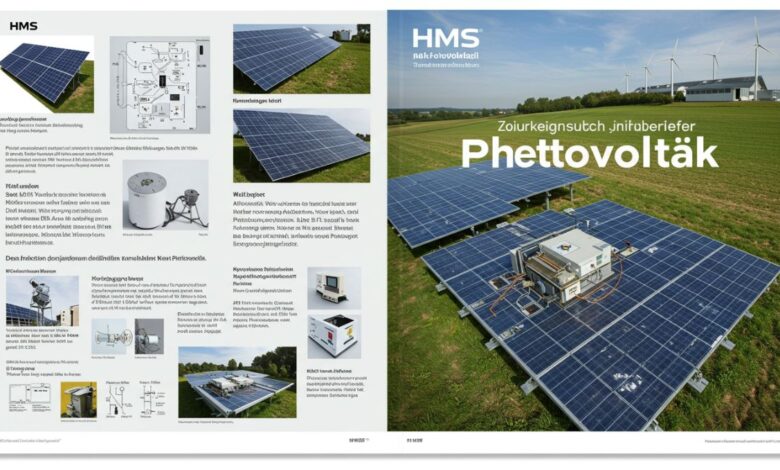HMS Photovoltaik: A Comprehensive Guide to Solar Technology
Harnessing solar energy with intelligent management systems for a sustainable and cost-efficient future.

In today’s energy-driven world, renewable sources of power are no longer optional—they are essential. One of the most promising solutions is HMS Photovoltaik, a modern approach to solar energy that combines photovoltaic technology with intelligent management systems. This integration allows solar panels to work more efficiently, making renewable power accessible, sustainable, and cost-effective for both households and industries.
This article explores the concept of HMS Photovoltaik, its working principles, applications, benefits, and the future role it will play in achieving global sustainability goals.
Understanding Photovoltaic Technology
What Does Photovoltaic Mean?
Photovoltaic (PV) technology refers to the direct conversion of sunlight into electricity using solar cells. These cells are made from semiconductor materials, typically silicon, that generate electrical current when exposed to sunlight.
The Role of HMS in Photovoltaik
The term HMS usually refers to Hybrid Management Systems or Home Management Systems. When applied to photovoltaic systems, HMS Photovoltaik implies a smart, integrated platform that controls, optimizes, and monitors solar energy production and usage.
In other words, while traditional PV systems focus only on capturing solar energy, HMS Photovoltaik ensures that this energy is distributed and used in the most efficient way possible.
The Components of HMS Photovoltaik
An HMS setup typically includes several key components working together:
-
Solar Panels (Modules): Capture sunlight and convert it into DC electricity.
-
Inverters: Transform direct current (DC) into alternating current (AC) for household or industrial use.
-
Energy Management System (EMS): The “brain” of the setup, monitoring production and consumption.
-
Storage Units (Batteries): Store excess energy for later use.
-
Monitoring Software: Provides real-time insights into energy efficiency, system health, and savings.
How HMS Photovoltaik Works
The process of HMS Photovoltaik can be broken down into three main steps:
-
Energy Generation: Solar panels absorb sunlight and convert it into DC electricity.
-
Energy Conversion and Storage: The inverter changes DC into usable AC, while surplus electricity is stored in batteries.
-
Smart Distribution: The HMS analyzes data to determine how and when to use solar energy, battery storage, or grid supply.
This intelligent system ensures maximum self-consumption, minimal waste, and significant cost savings.
Applications of HMS Photovoltaik
Residential Use
For households, HMS Photovoltaik offers energy independence and reduced utility bills. Smart systems allow homeowners to track consumption and optimize usage, especially during peak hours.
Commercial and Industrial Use
Businesses and industries benefit from a stable, predictable energy supply and lower operational costs. Large-scale Photovoltaik installations help companies meet sustainability goals while reducing reliance on fossil fuels.
Grid-Connected and Off-Grid Systems
-
Grid-Connected Systems: Excess electricity can be fed back into the grid, generating revenue or credits.
-
Off-Grid Systems: Useful in remote areas where traditional electricity supply is unavailable.
Advantages of HMS Photovoltaik
-
Energy Efficiency: Real-time monitoring ensures that no energy is wasted.
-
Cost Savings: Lower electricity bills and potential incentives make it financially attractive.
-
Sustainability: Reduced carbon emissions and reliance on fossil fuels.
-
Scalability: Systems can be expanded as energy needs grow.
-
Independence: Users gain greater control over their power supply, protecting against outages and price fluctuations.
Challenges Facing HMS Photovoltaik
While highly beneficial, HMS also faces certain challenges:
-
Initial Costs: Installation can be expensive despite long-term savings.
-
Weather Dependence: Solar output is affected by climate and location.
-
Technological Complexity: Requires integration of advanced software and hardware.
-
Maintenance: Regular monitoring and servicing are necessary to ensure efficiency.
Innovations in HMS Photovoltaik
Recent advancements are transforming the potential of Photovoltaik:
-
AI and Machine Learning: Enhancing predictive energy management.
-
Smart Grids: Allow seamless integration with national electricity networks.
-
High-Capacity Storage: Improved batteries for storing solar energy.
-
Modular Systems: Easy-to-upgrade setups for homes and businesses.
These innovations are making HMS more accessible, reliable, and efficient.
HMS Photovoltaik and Sustainability Goals
Global organizations, including the UN, emphasize renewable energy as a cornerstone of sustainability. HMS aligns perfectly with these objectives by:
-
Reducing greenhouse gas emissions.
-
Promoting clean energy adoption.
-
Encouraging decentralized energy production.
-
Supporting circular economy models.
By adopting HMS, societies take a significant step toward achieving carbon neutrality.
Future of HMS Photovoltaik
The future of Photovoltaik looks promising as demand for clean energy rises. We can expect:
-
Integration with Smart Homes: Appliances and systems that automatically adjust to solar availability.
-
Decentralized Energy Markets: Households selling excess power directly to consumers.
-
Affordable Solar Solutions: As technology matures, installation costs will drop further.
-
Global Expansion: Particularly in developing nations with high solar potential.
In essence, HMS Photovoltaik is not just a technology—it’s a vision for a sustainable and energy-independent future.
Conclusion
HMS Photovoltaik represents the fusion of traditional photovoltaic systems with intelligent management solutions. By combining solar power generation with smart monitoring, storage, and distribution, it maximizes efficiency and provides long-term economic and environmental benefits.
As renewable energy becomes increasingly vital, Photovoltaik stands at the forefront of innovation, offering households, businesses, and entire nations a sustainable path forward.




